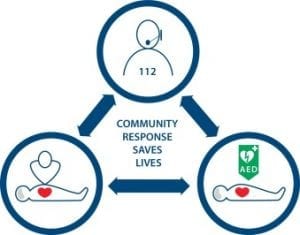Resuscitation, a crucial part of CPR restores the body’s vital functions during cardiovascular emergencies. The primary principle of resuscitation is simple prompt action followed by rapid response and effective intervention. Online CPR coursesnow offer comprehensive and industry updated curriculum on resuscitation.
On getting proper training on resuscitation, emergencies can be recognized early. This leads to positive patient outcomes and helps the patient get proper post-resuscitation care. Diving deep into the principles of resuscitation, there are several factors that impact the quality of CPR administered. Let’s study in-depth the principles of resuscitation and find out the ways to administer quality CPR effectively.
What are the Principles of Resuscitation?
The principles of resuscitation are a set of fundamental concepts. These concepts provide a structural approach to restoring and sustaining vital life saving functions. More like guidelines for healthcare experts, it primarily focuses on increasing the effectiveness of resuscitation. Let’s go through the principles of resuscitation one by one-
- Early Recognition: Prompt recognition of a medical emergency is critical for initiating timely intervention. Healthcare providers must be trained to identify signs and symptoms of conditions such as cardiac arrest, respiratory failure, or severe trauma.
- Early Activation: Once a medical emergency is recognized, activating the emergency response system or calling for help is essential to ensure that appropriate resources and personnel are mobilized promptly.
- Immediate Initiation of Basic Life Support (BLS): Basic life support techniques, including cardiopulmonary resuscitation (CPR) and defibrillation, should be initiated without delay. CPR helps maintain blood circulation and oxygenation, while defibrillation may be necessary to restore normal heart rhythm in cases of cardiac arrest due to certain arrhythmias.
- High-Quality CPR: Effective Cardiopulmonary Resuscitation involves proper technique, including adequate compression depth and rate, minimal interruptions, and adequate ventilation. Healthcare providers must be trained to perform CPR according to established guidelines that are updated to industry standards to optimize outcomes.
- Rapid Defibrillation: In cases of cardiac arrest caused by ventricular fibrillation or pulseless ventricular tachycardia, defibrillation should be administered promptly to restore normal heart rhythm. Automated external defibrillators (AEDs) may be used in community settings by trained individuals.
- Advanced Life Support (ALS):Advanced life support interventions, including airway management, intravenous access, administration of medications, and advanced cardiac monitoring, are provided by trained medical personnel to further support resuscitation efforts.
- Teamwork and Communication:Effective communication and collaboration among healthcare providers are essential during resuscitation. Clear roles, responsibilities, and communication channels help ensure coordinated care and optimize outcomes.
- Continuous Assessment and Adaptation: Resuscitation is a dynamic process that requires ongoing assessment of the patient’s condition and response to interventions. Healthcare providers must be prepared to adapt treatment strategies based on changing circumstances.
- Post-Resuscitation Care: Following successful resuscitation, patients require ongoing monitoring and care to stabilize their condition. It also includes addressing underlying causes that might surface to prevent complications, and support recovery.
What are the types of Resuscitation?
Certification training on resuscitation can help you understand the dynamics and principles required to administer quality CPR. But originally, there is much to it.To perform CPR effectively, you need to know more than just the principles of resuscitation. To understand and to be able to administer it effectively, it is important to note that there are several types of resuscitation. Let’s go through each one of them-
- Cardiopulmonary Resuscitation (CPR): Involves chest compressions and rescue breaths to maintain blood circulation and oxygenation during cardiac arrest or respiratory failure.
- Defibrillation: Administering an electrical shock to the heart to restore normal rhythm in cases of life-threatening cardiac arrhythmias like ventricular fibrillation.
- Advanced Life Support (ALS): Advanced medical interventions provided by healthcare professionals to support resuscitation efforts, including airway management, medication administration, and cardiac monitoring.
- Neonatal Resuscitation: Specialized care for newborns needing assistance with breathing or circulation after birth, often involving techniques like suctioning and positive-pressure ventilation.
- Trauma Resuscitation: Stabilizing individuals with severe injuries from accidents or trauma, focusing on airway control, hemorrhage management, and fluid resuscitation.
- Pediatric Resuscitation: Managing medical emergencies and cardiac arrest in children and infants, requiring adaptations for their unique physiology and anatomy.
- Specialized Resuscitation Techniques: Other specialized procedures like extracorporeal membrane oxygenation (ECMO) or therapeutic hypothermia used in specific circumstances to support resuscitation efforts.
Each type of resuscitation requires individual training. It demands separate tools, equipment and expertise.
Conclusion
The principles of resuscitation forms the foundation of precise emergency care. When these guidelines are followed critical emergencies can be altered. With the help of early recognition and activation of emergency systems, healthcare professionals can optimize outcomes for patients. Several online CPR classes provide comprehensive education on resuscitation. These modules are updated with current industry standards and enable learners to ace a lifesaving skill from the comfort of their homes.
A thorough understanding and application of these principles help provide timely care which ultimately promotes positive outcomes.

